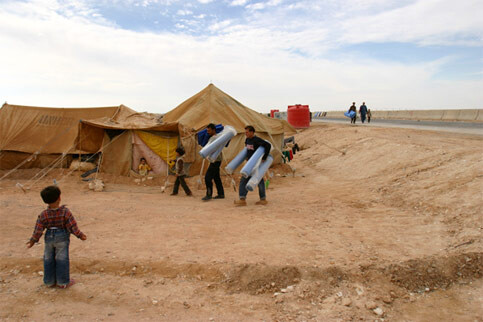The Electronic Intifada 4 May 2007

Tents at Al-Tanf have had to been replaced three times because of severe flooding. (Thierry Esch/Paris Match/UNHCR)
DAMASCUS, 3 May 2007 (IRIN) - Over 1,000 Iraqi-Palestinian refugees stranded in camps on the Syrian-Iraqi borders are sinking into despair as their situation continues to deteriorate and a solution to their plight remains elusive.
“We are losing hope,” one refugee in the Al-Tanf camp, who requested anonymity, told IRIN. “There are problems between husbands and wives because of the situation and we are afraid for the future of our children. We are searching for a solution, but it does not exist.”
Over 1,000 Palestinians are marooned in no-man’s land at the Al-Tanf and Al-Waleed camps on the Syrian-Iraqi borders as well as Al-Hol camp just inside Syria. They fled the violence in Iraq only to be refused entry into Syria by the Syrian government.
Camp conditions “absolutely dire”
As Al-Tanf heads towards its one year anniversary in June, life in the tented camps is fraught with anguish and daily struggles.
In the last few days a pregnant woman attempted and failed to commit suicide, while at the end of April a fire swept across the Al-Tanf camp leaving 28 refugees injured. Several deaths and miscarriages have been reported, and having endured the cold and floods of winter the refugees are now living under dust storms and the heat of the approaching summer.
“The conditions are absolutely dire, [the camps] are places where people are dying. No man, woman or child should be living in that environment,” said Sybella Wilkes, spokesperson for the UN Refugee Agency (UNHCR) in Damascus, one of the few organisations able to gain access to the camps.
No solution in sight
As the situation worsens, there is no immediate prospect of a solution. The only proposal thus far, an offer by the Palestinian Authority to take in the refugees, was rejected by Israel.
“At the moment there is nothing that we can tell the Palestinian refugees that is going to happen. We tell them that we think about them and we’re talking about them,” said Wilkes. “We never want them to feel that they’re forgotten.”
The permanent doctor for the camps is hugely over-stretched and while the UNHCR and the Syrian Red Crescent continue to provide ambulance cover as well as food and water deliveries, the health of the refugees, who include several hundred children, is deteriorating.
Unlike the majority of Iraqi refugees who are still free to enter Syria, Palestinian refugees from Iraq have been prevented from entering since May last year, with the government fearful of a large influx of extra Palestinians.
“The Syrians are saying that we have 450,000 Palestinians already, since 1948 and 1967, and that is enough,” said Wilkes.
With no legally-recognised homeland, regional governments are worried that the Palestinians — unlike the Iraqis whom they believe will eventually return home — will remain indefinitely.
Since the fall of former Iraqi President Saddam Hussein, the Iraqi Palestinian community has been systematically attacked because of the favourable conditions it enjoyed under the old regime.
According to the United Nations, close to 200 Palestinians have been killed in Iraq since the US-led invasion of the country began in March 2003.
This item comes to you via IRIN, a UN humanitarian news and information service, but may not necessarily reflect the views of the United Nations or its agencies. All IRIN material may be reposted or reprinted free-of-charge; refer to the copyright page for conditions of use. IRIN is a project of the UN Office for the Coordination of Humanitarian Affairs.
Related Links


